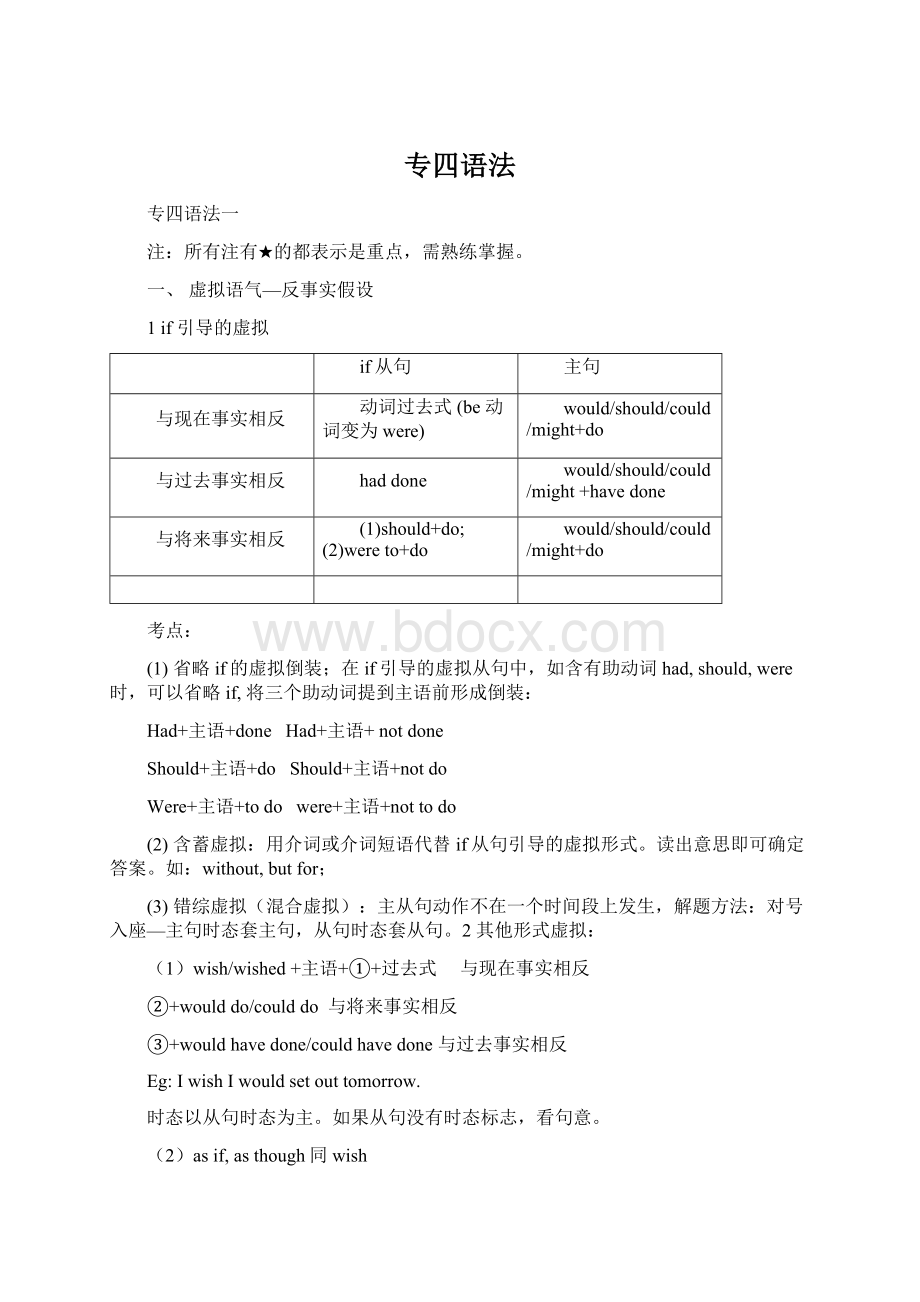专四语法Word格式文档下载.docx
《专四语法Word格式文档下载.docx》由会员分享,可在线阅读,更多相关《专四语法Word格式文档下载.docx(21页珍藏版)》请在冰豆网上搜索。

1划出标志词;
2选出动词原形。
①宾语从句:
主语+谓语(建议、命令、要求)+that+主语+(should)do
②主语从句:
Itis/was+adj/Ved+that+主语+(should)do
Done:
proposed,,requested,suggested,advisable,recommended,desired,desirable,urgent,imperative★,important,vital,essential,necessary;
③表语从句/同位语从句:
suggestion,proposal,advice,requirement,request,command,recommendation,desire,motion,demand.
表语从句:
主语(表示建议、命令、要求)+系动词+表语
Mysuggestionisthathegowithustomorrow.
同位语从句:
主语(表建议、命令、要求)+that+…+谓语+宾语
Mysuggestionthathegowithusisright.
(6)★Itis/wastime/hightime/abouttime+主语+did早该做某事了。
(7)lest/forfear/incasethat+主语+shoulddo(此处should一般不省略):
以免,万一。
(8)★跳层虚拟:
真实+or/otherwise+虚拟
虚拟+but+真实
跳层虚拟常考过去式,跳层虚拟一般用couldhavedone,wouldhavedone.
Ididnotstudyhard.OrIcouldhavepassedtheexam.
IcouldhavepassedtheexambutIdidnotstudyhard.
IwouldhavecalledyoubutIdidnotknowyourtelephonenumber.
3情态动词+havedone:
对过去事情的推测;
Musthavedone对过去事情的肯定猜测
Itmusthaverainedlastnight.
(mustn’thavedone×
)
Should/oughttohavedone该做而未做(含责备)
Youshouldhavecomeandattendedthemeeting.
Shouldnot/oughtn’ttohavedone不该做而做了(含责备)
Youshouldnothavegonetoseethemovie.
Needn’thavedone做了不必做的事
Couldhavedone能够做而没做
Mayhavedone(弱语气)或许,不肯定的猜测
Needdo,作情态动词;
needtodo作实义动词
Needdoing=needtobedone
专四语法二
二、非谓语
Todo/nottodo
Doing/notdoing
Done
固定搭配及固定句型,按单词记;
非谓语常考成份:
非谓语作状语的区别★,和作定语的区别。
(一)todo/nottodo
1时态、语态
vt
vi
主动
被动
一般式★
Todo
Tobedone
完成式★
Tohavedone
Tohavebeendone
进行式
Tobedoing
×
完成进行式
Tohavebeendoing
todo一般式表示动作将要发生或同时发生;
不定式完成式表示动作要先于主句谓语动作之前发生。
不定式完成式不能做定语。
2常考固定搭配和固定句型
(1)V+todo:
todo做宾语
常跟不定式做宾语的谓语动词有:
aim,ask,agree,claim,bother,fail,pretend,tend,plan,refuse,prepare,volunteer,besaidtodo,bebelievedtodo,
常用不定式的句型:
Ittakessbsometimetodo.
Itisadj.forsb/ofsbtodo.(adj修饰todo时用for;
adj修饰sb时用of)
(2)V+do:
使役动词:
常考主动:
let,make,have;
感官动词:
常考被动。
(变为被动语态时,原来省略的to要加上。
Let,make,have+sb+do
Thebossmadehimworkdayandnight.
Hewasmadetoworkdayandnight.
Havesthdone①遭遇不幸;
②让某人做某事
Hehashiswalletstolen.
Ihavemyhaircut.
Getsthdone/makesthdone;
getsbtodo
Igotmybicyclerepaired.
See/hear/notice/watch/feel+sb+doing(强调正在进行)/do(强调动作的全过程或表示将要)
3成份:
除谓语外的所有成份:
主语,宾语,表语,定语,状语,补语。
(1)不定式作主语与动名词作主语区别:
todo表具体的,一次性的动作;
而动名词表示一般的,抽象的,多次性的动作。
(2)不定式作表语。
betodo计划好,规定好的事,表将要的动作。
IamtostudyEnglishabroad.=IamgoingtostudyEnglishabroad.
(3)作定语。
名词+todo/tobedone表示将要
名词+doing/beingdone表示进行
名词+done表示完成,表被动。
Themeetingtobeheld/themeetingbeingheld/themeetingheld
(4)作状语:
①Todo,主谓宾(表目的)=Inordertodo,主谓宾。
Topasstheexam,wecamehere.=Inordertopasstheexam,wecamehere.
②主谓宾+todo/inordertodo表目的
主谓宾+soastodo不能用于句首
WecameheretostudyEnglish/inordertostudyEnglish/soastostudyEnglish.
③主谓宾,todo/inordertodo表结果
Hestudiedhard,topasstheexam.
Ipickedupthephone,onlytofindthatitwasawrongnumber.
作状语时,一般用todo,而不用doing/done。
(二)doing/notdoing动名词/现在分词
1时态、语态
一般式
doing
Beingdone
完成式
Havingdone
Havingbeendone
注意:
doing一般式表动作同时发生;
havingdone表示动作先于主句谓语动作之前发生;
havingdone不做定语。
2doing成份:
动名词:
主★、宾★、表、定
现在分词:
状★、定★、补、表
动名词与现在分词作表语区别:
Iamstanding.≠StandingisI.(分词)
Myhobbyisstanding.=Standingismyhobby.(动名词)
定语区别:
①只表示用途为动名词;
asleepingcar≠acarwhichissleeping
=acarusedforsleeping
②能转成定从的为分词;
asleepinggirl=agirlwhoissleeping.
3动名词考点:
①固定搭配及固定句型;
②one’sdoing;
(one是doing的逻辑主语)宾格代词+doing:
mydoing;
medoing
常考动词:
mind,risk,appreciate,resist,escape(vt.逃避viescapefrom逃跑),enjoy,admit,suggest(suggest当建议讲时,后面的that从句用虚拟,谓语用shoulddo;
suggest当暗示讲时,=indicate后面的从句用普通时态。
),considertodo认为/considerdoing考虑,delay=postpone=putoff=setback(指时间)推迟,holdup(指具体)耽误,abandon=giveup=partwith=quit,acknowledge,advocate,tolerate=putupwith=stand=bear,
Somebodyspendtime/moneyonsth/(in)doingsth.
Thereisnopointindoingsth.
Itisuseless/nouse/nogooddoingsth.
Sbhavedifficulty/troubleindoingsth.
Beworthdoing
③V+todo与V+doing区别:
Remembertodo未做/rememberdoing已做;
forgettodo/forgetdoing;
regrettodo未发生遗憾/regretdoing已发生后悔
Iregrettednotjoiningyourpartylastweek.(动作已发生,所以用doing)
Ineverregrettednotacceptingtheoffer,foritwasnotwheremyinterestlay.(1993.42)
Meantodo打算;
meandoing/N/that从句:
意味着
Trytodo试图,努力;
trydoing试一试,尝一尝
Stoptodo停下来去做;
stopdoing禁止做
Continuetodo继续做另外一件事;
continuedoing接着做同一件事
Goontodo/goondoing(与continue一样)
(三)现在分词与过去分词区别
Done+N已完成;
doing+N正在进行
现在分词四种形式:
doing,beingdone,havingdone,havingbeendone
过去分词一种形式:
done(及物动词的过去分词表示被动,不及物动词的过去分词表示完成。
aretiredworker,fallenleaves,bloomedflowers.
1作定语与不定式区别(见不定式)
2作状语与不定式区别;
(1)分词,主谓宾:
表示时间,原因,条件
对比:
todo,主谓宾:
表目的。
Be+adj/n:
永远没有被动形式。
__ateacher,onehastobeastudentfirst.
(2)主谓宾,分词(表示伴随,方式,结果)
选择结果状语时,不定式优先考虑,其次再考虑分词。
1先判断主被动关系。
即分词与句子主语之间如果是逻辑上的主谓关系时,分词用主动式doing,havingdone;
如是逻辑上的动宾关系时,分词用被动:
beingdone,havingbeendone,done.
Seenfromthetopofthehill,thecitylooksbeautiful.
Seeingfromthetopofthehill,Ifindthecitybeautiful.
2再判断动作先后,即分词动作发生在主句谓语动作之前时,分词用完成时:
havingdone,havingbeendone.
3Havingbeendone强调正在进行;
done强调已完成
4避免非谓语悬垂,即避免非谓语动词没有逻辑主语。
Leavingtheroom,thedoorwaslocked.×
Leavingtheroom,helockedtheroom.√
⑤连词+分词,主谓宾(时间,原因,条件)(句子主语为分词的逻辑主语或宾语)
主谓宾,连词+分词(伴随,方式,结果)(句子主语为分词的逻辑主语或宾语)
连词+todo×
After/before:
after/beforedoing/beingdone√
After/beforedone×
after/beforetodo×
(3)分词独立主格:
名词+分词,主谓宾。
(需判断名词与分词之间的逻辑主谓、动宾关系。
With+名词+分词,主谓宾。
主谓宾,名词+分词。
主谓宾,With+名词+分词。
Awomancamein,withababy(being)inherarms.(being分词可省略。
在英语句子中,逗号是不能连接两个独立完整的句子的。
主谓宾,主谓宾。
连词+主谓宾,主谓宾。
√
非谓语,主谓宾。
★非谓语考点:
①固定搭配;
fortheretobe;
oftherebeing
②作成份:
状语,定语;
作状语形式:
分词状语;
连词+分词;
独立主格。
专四语法三
三、三大从句
名词性从句:
主从,宾从,表从,同位语从句(重点关联词:
that,which,what,as)
形容词性从句:
定语从句
副词性从句:
状语从句
(一)状语从句
只要读懂意思即可选答案,考的频率较高。
1让步状从:
(1)although,though,evenif,eventhough
Evenadv只能修饰句子,不能连接句子。
despite/inspiteofprep.只能接名词。
(2)as引导的让步倒装:
Adj/adv/n(无冠词)/分词+as+主谓,主谓宾
AlthoughIambusy/BusyasIam,…
Althoughheisachild/Childasheis,…
AS+①固定搭配如:
bedefinedas,regardas
②时间状语从句:
主从句主语要一致,主从句动作同时发生。
③原因状语从句:
在说话人看来很明显的理由。
④方式
⑤定从:
限定性定语从句与非限定性定语从句
⑥比较状从:
HeisastallasI(am).
⑦让步倒装
⑧介词:
与like区别
(3)while引导的让步状从
①句首,相当于although,though;
②表转折,放在句中,相当于but;
③当。
。
时候;
while从句谓语动词用延续性,而when从句动词为非延续。
(4)nomatter+疑问词(what,where,how)=疑问词+ever引导的让步状从:
However=nomatterhow
两者都可以引导让步倒装,但只有疑问词+ever可引导名词从句。
However+adj/adv+主谓,主谓宾。
Howeverstrongheis,主谓宾。
Howeverfastheruns,主谓宾。
2比较状从
一般由as,than引导(见形容词、副词比较结构)
3条件状从:
(1)if,unless(=ifnot),provided,providing,suppose,supposing倘若
If:
①条件状从:
真实条件
虚拟条件
②宾从:
“是否”
Whether:
①让步状从:
“无论如何”,“无论是否”
②名从:
主从“无论是否”
宾从
表从
同位从
If和whether只有在引导宾从时可以互换。
whether可加ornot,而if不可。
(2)条件状从:
aslongas,solongas,onconditionthat,intheeventthat,incase(连词),incaseof+N(介词词组)
4时间状从
(1)when,while,as(主从句主语一样,动作同时发生)
(2)hardly…when…刚。
就。
Scarcely…when…刚。
Nosooner…than…刚。
Not…until…直到。
才。
(3)theminute=themoment=theinstant=assoonas
Thefirsttime/secondtime/thirdtime/lasttime/nexttime/eachtime/everytime/theday/bythetime
(4)since,till,until(till一般不放在句首),once,before,after
Not…until…(主句动作非持续)
Till,until(主句动作可持续)
Ididnothavesupperuntilhecame.
Iwaitedtillhecame.
5结果状从:
soadj/adv…that…
Such(a/an)adj+N+that…
Withtheresultthat…(asaresult是副词词组,不引导句子)
Sothat以便,inorderthat为了
6原因状从
Because=inthat,
since=nowthat:
强调人们已知的理由;
as:
强调在说话人看来很明显的理由;
for:
表示推理得出的理由,表理由时不放在句首。
7地点状从:
where,wherever
8方式状从:
as,justas,muchas正如。
TheytrytoconcealthefactjustasIdid.
(二)名从:
主从,宾从,表从,同位从
①抓连词:
连接词:
that,whether,if;
连接代词:
what,which,who,whom
连接副词:
when,where,how,why
②抓连词在名从中的成份:
连接词:
只起加接作用,不充当从句中成份;
连接代词:
既连接从句,又在从句中充当主、宾、表、定语;
连接副词:
既连接从句,又在从句中充当状语。
连接词
词义
是否在从句中充当成份
能否省略
That★
无
不充当
作宾语时可省
Whether
不可省
if
不充当(引导宾从)
连接代词
what★
“什么”
主宾表
Which
“哪一个”
定语
who
“谁”
主语
whom
宾语
连接副词
How
方式
状语
Where
地点
when
时间
Why
原因
That的考点:
代词:
连词:
①名从中的连接词:
与what区别;
②限定性定从中的关系代词:
与which区别;
③强调句式;
④状从中的连接词:
inorderthat…;
sothat…
(1)that引导的名从:
主从,宾从,表从,同位从,只起连接作用,不在从句中充当成份。
That+完整句子。
①that引导的主语从句:
Itis/wasadj